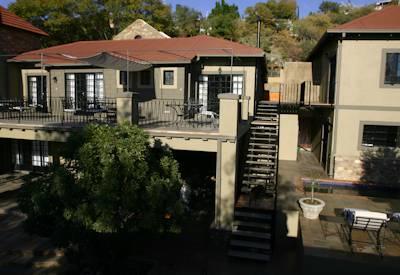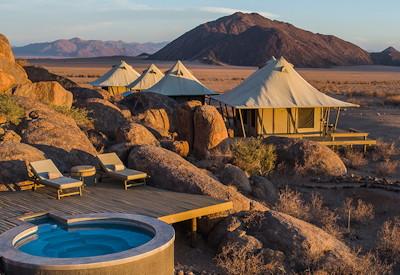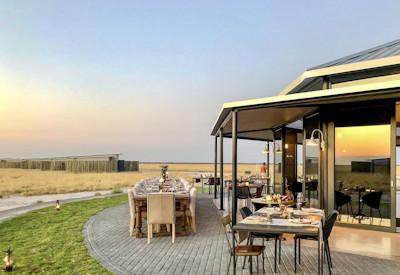
Fish River Canyon
Absolutely magnificent and breathtaking in its immensity, The Fish River Canyon in Namibia is the second largest canyon in the world. Formed by water from the Fish River flowing through an arid environment over millions of years, the landscape here is desolate, dusty and rock-strewn with enticing hills and chasms.
Fish River Canyon Facts
- Size: 160km long, up to 27km wide and up to 550m deep
- When to visit: Year-round
- Rainfall: Erratic, 10mm to 40mm per annum, varying with flash floods occurring often
- Altitude: varies from 366m to 609m above sea level
- Location: South-Eastern Namibia
- Accommodation: Lodges near Fish River Canyon
Information On Fish River Canyon
Absolutely magnificent and breathtaking in its immensity, The Fish River Canyon in Namibia is the second largest canyon in the world.
Formed by water from the Fish River flowing through an arid environment over millions of years, the landscape here is desolate, dusty and rock-strewn with enticing hills and chasms. It is surrounded by high, forbidding cliffs, and winds along a distance of approximately one hundred miles through the fissured Koubis Massif all the way down to the sulphurous Ai-Ais Hot Springs. The fantastic views of this majestic canyon make it a popular hiking destination, and there is a terrific 5 day, 86 km trek along the canyon floor.
After heavy rainfall, The Canyon quickly turns into a raging river although it usually carries only a small amount of water, being dammed up in the town of Hardap. The main viewpoint for the Canyon is at Hobas near the northern end of the canyon. The 60ºC sulphurous springs at Ais-Ais (from the Nama word meaning 'burning water') originate deep underground and are rich in minerals which are reputedly beneficial for those with rheumatic or nervous disorders. Ais-Ais falls within the Fish River Canyon conservation area, and the hot springs are a public facility.
The fantastic 5-day hike offers thrills to adventure seekers and travellers alike. Absolutely no facilities are provided, and you carry everything with you and find whatever water you can in semi-permanent pools. Due to the risk of flooding and the high summer temperatures, the hiking trail is only open from May 1st to August 31st.
Wildlife, while not as concentrated here as in other areas (such as Etosha and Caprivi), do include troops of Chacma baboons and isolated groups of klipspringers while mountain zebra and kudu are rare. The area attracts an interesting variety of colourful birds and raptors such as rock kestrels, and lanner falcons ride the thermals.
Where is Fish River Canyon located?
Located within the /Ai / Ais-Richtersveld Transfrontier Park (Namibia and South Africa), the canyon though is situated in the southeastern region of Namibia.
- Luderitz to Hobas = 418km
- Luderitz to Ais-Ais = 458km
- Sesriem to Hobas = 568km
- Sesriem to Ais-Ais = 630km
- Vioolsdrif (South Africa/Namibia border post) to Hobas = 168
- Vioolsdrif (South Africa/Namibia border post) to Ais-Ais = 121km
Here is a link to a map of the canyon; Google Maps - Fish River Canyon
Best Time to Visit Fish River Canyon?
One can visit the canyon year-round, although it must be noted that the summer months can be exceptionally hot, with temperatures in the late 30's and early 40's (degrees Celcius).
Winter mornings can be very cold, with temperatures dropping below zero (degrees Celcius).
If you are not affected by heat, look at the Fish River canyon as a year-round destination, but if you are looking to avoid the heat, look at the winter and autumn months (June to October).
Main Attractions Of Fish River Canyon
- The second-largest canyon in the World
- Stunning views, especially at sunrise and more so, sunset
- 86km Fish River Canyon hike
- Therapeutic hot springs at Ais-Ais
- Sunsets drinks at the viewpoint near Hobas
- Olive Grove Guesthouse
TThe Olive Grove Guesthouse in Windhoek is a stylish retreat in a quiet suburb, close to the city center. It offers a perfect mix of comfort and convenience, with free Wi-Fi and a relaxing swimming pool and outdoor area.
Its location is ideal, just a short walk from the renowned Joe's Beer Garden, making it perfect for travelers seeking relaxation and convenience. Olive Grove is a hidden gem, offering a peaceful escape with amenities that guarantee a memorable stay in Windhoek.
- Wolwedans Boulders Camp
Nestled deep within the breathtaking NamibRand Nature Reserve, Wolwedans Boulders Camp is a sanctuary of tranquillity and luxury. Surrounded by the dramatic beauty of giant granite boulders and endless desert plains, the camp offers guests an exclusive opportunity to connect with the untamed wilderness.
Boulders Camp is the perfect retreat for those seeking solitude and a deeper connection with nature. With only a few carefully designed tents, the camp offers unmatched privacy, ideal for escaping the ordinary. Guests can enjoy guided walks, scenic drives, and serene moments in the stunning desert.
- Chobe Princesses Houseboats
An unforgettable safari experience unlike any other awaits aboard the three luxurious "Chobe Princess." These exceptional houseboats offer a unique way to immerse yourself in the breathtaking wildlife of the Chobe River.
Imagine spotting majestic elephants, graceful antelope, and countless bird species right from the comfort of the boat's deck or venturing out on expertly guided game drives for an even closer encounter with nature.
- Desert Horse Inn
Desert Horse Inn is a spectacular base for exploring the captivating southern Namib Desert. It offers the perfect gateway for a day trip to Lüderitz, the iconic ghost town of Kolmanskop, or the rare chance to spot the elusive desert horses.
Whether you choose to embark on thrilling mountain biking and walking excursions or simply soak in the serene beauty of this unique desert landscape, this destination promises an unforgettable experience. Discover an extraordinary side of the Namib that will leave you in awe.
- Etosha King Nehale
Located on the edge of Etosha National Park, Etosha King Nehale Lodge offers a memorable escape into Namibia's stunning wildlife and landscapes. Overlooking plains and waterholes visited by majestic animals, this Lodge combines tranquillity and adventure, perfect for a honeymoon or getaway.
Blending modern luxury with traditional Namibian design, the Lodge features spacious suites with all the comforts for a relaxing stay. Each suite immerses guests in the surrounding beauty with private plunge pools and décor inspired by the region's rich culture.
- Kalahari Red Dunes Lodge
Nestled in Namibia's stunning Kalahari Desert, Kalahari Red Dunes Lodge offers an unforgettable safari experience. The lodge combines adventure and comfort, letting guests explore red sand dunes, golden savannahs, and vibrant wildlife.
Kalahari Red Dunes Lodge is the perfect base for exploring the Kalahari Desert. Enjoy guided game drives; nature walks, or peaceful sundowner excursions to see wildlife like springboks, oryx, and birds of prey up close.






